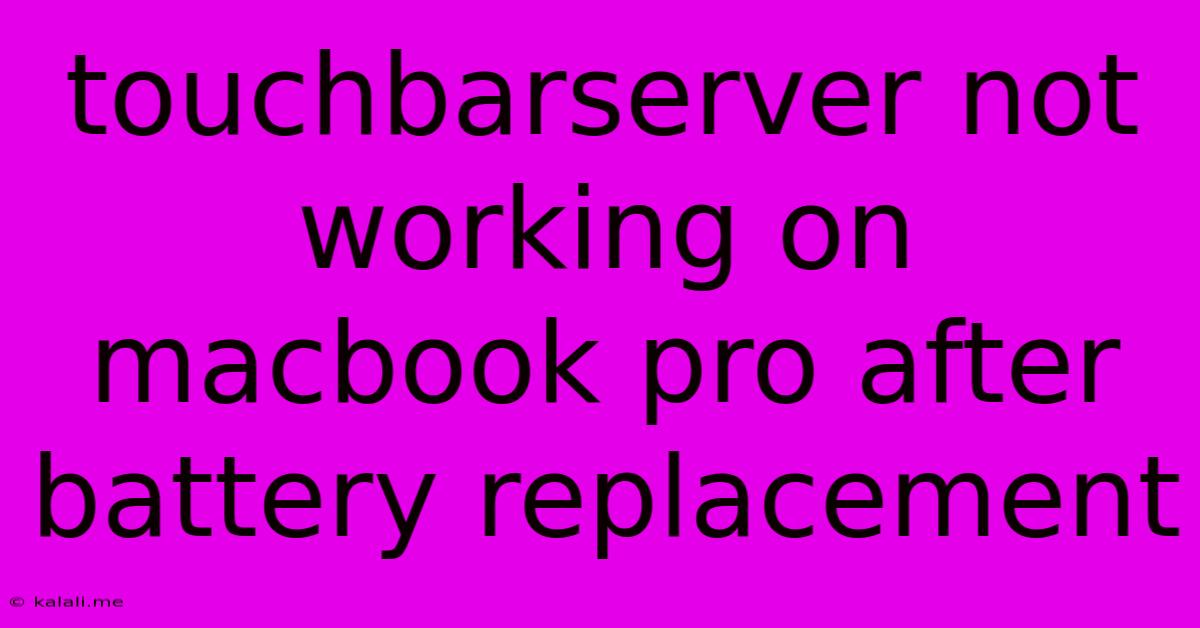Touchbarserver Not Working On Macbook Pro After Battery Replacement
Kalali
Jun 08, 2025 · 4 min read

Table of Contents
Touch Bar Server Not Working After MacBook Pro Battery Replacement: Troubleshooting Guide
Replacing your MacBook Pro's battery can sometimes lead to unexpected issues, and one frustrating problem is a malfunctioning Touch Bar. If your Touch Bar isn't working after a battery replacement, you're not alone. This article will guide you through troubleshooting steps to get your Touch Bar back up and running. This often involves checking for loose connections, software glitches, and ensuring your system is properly configured.
Understanding the Problem: Why Your Touch Bar Might Stop Working
The Touch Bar, a key feature of many MacBook Pros, relies on a complex interplay of hardware and software. During a battery replacement, even a seemingly minor disruption to the internal connections can affect its functionality. This could involve loose cables connected to the logic board, a software conflict after the system restart, or even a faulty Touch Bar itself (though this is less common). Therefore, a systematic approach to troubleshooting is necessary.
Troubleshooting Steps: Resolving Touch Bar Issues After Battery Replacement
Let's tackle this problem step-by-step:
1. Verify External Connections & Restart: The Simple Fixes
Before diving into complex solutions, try the basics:
- Ensure all cables are securely connected: After the battery replacement, double-check that all internal connections, particularly those related to the Touch Bar and logic board, are firmly seated. A slightly loose connection can disrupt functionality.
- Restart your MacBook Pro: A simple restart can often resolve minor software glitches that may be interfering with the Touch Bar's operation. Try a forced restart (hold down the power button until the machine shuts down) if a normal restart doesn't work.
- Check for external display issues: If you are using an external display, try disconnecting it. Sometimes external display configurations can conflict with the Touch Bar.
2. SMC Reset: Addressing Power Management Issues
The System Management Controller (SMC) manages various low-level functions, including power and the Touch Bar. Resetting the SMC can sometimes resolve problems related to power management:
- For Intel-based MacBook Pros: Shut down your MacBook Pro, unplug the power adapter, and press and hold the Shift+Control+Option keys simultaneously. While holding these keys, press the power button. Hold all keys for about 10 seconds, then release them. Press the power button to turn your MacBook Pro on.
- For Apple silicon MacBook Pros: There's no SMC to reset on Apple silicon Macs; proceed to the next step if this didn't work.
3. NVRAM/PRAM Reset: Clearing System Settings
The Non-Volatile Random-Access Memory (NVRAM) or Parameter RAM (PRAM) stores certain system settings. Resetting it can sometimes resolve issues affecting the Touch Bar:
- Shut down your MacBook Pro.
- Turn it back on and immediately press and hold Option+Command+P+R.
- Hold these keys until you hear the startup sound twice (or see the Apple logo appear and disappear twice on newer Macs).
- Release the keys and allow your MacBook Pro to boot up normally.
4. Check for Software Updates: Ensuring Compatibility
Outdated system software can cause compatibility problems. Ensure your macOS is up-to-date:
- Go to System Settings > General > Software Update.
- Install any available macOS updates.
5. Boot in Safe Mode: Identifying Software Conflicts
Booting in Safe Mode disables non-essential startup items and extensions. If your Touch Bar works in Safe Mode, a third-party application or extension is likely the culprit.
- Restart your MacBook Pro.
- Immediately press and hold the Shift key.
- Release the Shift key once you see the login window.
- If the Touch Bar works in Safe Mode, gradually re-enable startup items and extensions to identify the problematic one.
6. Apple Diagnostics: Identifying Hardware Issues
If none of the above steps resolve the issue, run Apple Diagnostics:
- Shut down your MacBook Pro.
- Turn it back on and immediately press and hold the D key.
- Follow the on-screen instructions.
Apple Diagnostics will test your hardware and provide a diagnostic code. Note this code down and contact Apple Support for further assistance. A hardware fault might require professional repair.
7. Contact Apple Support: Seeking Professional Help
If you've exhausted all troubleshooting options and your Touch Bar still isn't working, it's time to contact Apple Support or an authorized Apple service provider. They can diagnose the problem and provide the necessary repairs.
By systematically following these troubleshooting steps, you stand a much better chance of getting your Touch Bar back to full functionality after your MacBook Pro battery replacement. Remember to always prioritize safe handling and careful reassembly if you undertake the battery replacement yourself.
Latest Posts
Latest Posts
-
How To Tell What Speed Your Bike Is
Jun 08, 2025
-
How To Fix A Leaking Aquarium Without Draining
Jun 08, 2025
-
How To Rid Gophers And Moles
Jun 08, 2025
-
How Do I Unsubscribe From Facebook
Jun 08, 2025
-
Can Forget Me Not Plant Be Planted Hydroponically Indoors
Jun 08, 2025
Related Post
Thank you for visiting our website which covers about Touchbarserver Not Working On Macbook Pro After Battery Replacement . We hope the information provided has been useful to you. Feel free to contact us if you have any questions or need further assistance. See you next time and don't miss to bookmark.